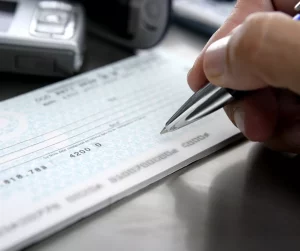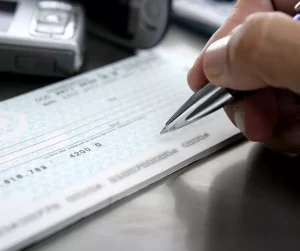 Do you need to worry about check fraud? Take a look at one of your Company cancelled checks. You will see your:
Do you need to worry about check fraud? Take a look at one of your Company cancelled checks. You will see your:
- Name and address
- Company logo
- Check number
- Bank account number
- Bank’s routing number
- The exact signature of an authorized check signer
What Could Go Wrong?
Fraudsters have been very busy creating and cashing fraudulent corporate checks. What was once costly to do is now relatively simple using a quality color printer, check quality paper and Photoshop. Banks will generally not cash checks unless the holder has an account there – unless presented for payment at the payor’s bank.
You would think the bank would be responsible for cashing a bad check. Not necessarily so. Big banks have investigation units, not to catch the fraudster, but to try and see if someone in your Company was, in some way, complicit. If it is an “inside job” you have no chance of being reimbursed for check fraud. Even if you were not at fault in any way there is no guarantee of reimbursement.
Interestingly, this fraud technique is much harder to do with personal checks. They are generally held to higher scrutiny when presented for payment plus personal checks almost always are removed from a checkbook, leaving a perforated edge on the top or side. Bank tellers are taught to look for that.
Thankfully there are controls you can implement to avoid or at least minimize check fraud.
1. Monitor Banking Activity for Check Fraud
It once was good business practice to reconcile the bank account as soon as it was received and identify any unauthorized transactions. In 2021 this is not close to sufficient. I suggest you have someone in accounting monitor cleared transactions daily. In most companies there is not that much daily activity and it can easily be done online using virtually any bank. True, this is a “detective control” and only identifies a problem after it occurs– but it only occurs just once.
2. Positive Pay
Positive Pay is an automated cash management service used by companies in conjunction with their financial institution to deter check fraud. As you prepare a batch of checks you will electronically send your bank the amount, check number, dollar amount and, in some cases, the payee of each check. If a check is presented for payment and these items do not match, the check will not clear. Of course the more non-electronic checks you write the more laborious this process becomes. I suggest you minimize the amount of hand checks – there are not that many “emergencies.”
Of course there is a bank charge for this valuable service which might be negotiable to some extent.
3. Reverse Positive Pay
A variation of Positive Pay is Reverse Positive Pay. This system requires the Company to monitor their checks on their own, making it the Company’s responsibility to alert the bank to decline the check. Seems like more work and it is but the point is the bank does less work so fees for this service can be substantially less. And, if you have taken my first suggestion to monitor checks daily this may not be an issue for you. Obviously your accounting staff member needs to be responsible and diligent.
Your bank’s marketing department may use different terms for Positive Pay and Reverse Positive pay but they will know to what you are referring.
4. Pay Most or All Bills Online and Avoid Check Fraud
Almost certainly you are using (Automated Clearing House) ACH payments currently. Payments of bank service charges, payroll and payroll taxes among others are electronically removed from your account. Why not use ACH your payment option of choice? Again, there is a bank charge for this service – generally 25 – 30 cents per ACH. Compare that to the cost of postage and the extra work it takes to mail a check; not to mention the recent USPS service problems. One downside to this is set-up time is significant as your vendors need to provide you with their banking information. Also, if choosing this route you must set up proper controls – including Positive Pay for ACH transactions. Remember you will no longer be receiving duplicate copies of cancelled checks from your bank. Instead each ACH is described (sometimes somewhat cryptically) as a line item on your bank statement.
So there you have it – a reason to lose sleep at night followed by reasons to sleep well.
Your bank should be more than happy to discuss any of the above options with you. I urge you to review available options and implement cash controls that are effective and affordable.
Alternatively, please feel free to contact me or your HW & Co. service representative with any questions or for additional information on check fraud.
@2021







